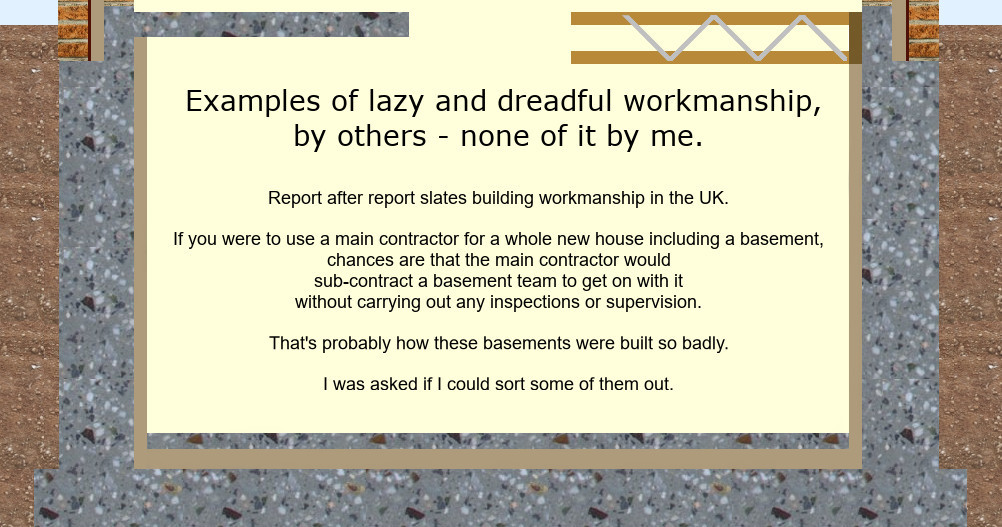| |
How not to build a basement
Building a basement badly can be due to a don't care attitude or inexperience leading to mistakes.
1. The first third is a useful discussion.
|
2. The next third, in a blue bordered box, is many examples of what experienced contractors did wrong. None of these are mistakes. These were deliberately cheating the customer on quality to save time and increase profit. Go straight there.
|
|
3. The last third is a list of mistakes clients made.
Discussion.
The worst two mistakes would be employing a main contractor who hands the basement over to a team of sub-contractors without monitoring their work.
And using ICF. I have a page explaining the many reasons why ICF basements have proven to be a huge mistake here.
Both these choices would be breaking the law today. The building Safety Act and other changes are in full effect now - and the biggest punishments are for developers and clients allowing mistakes to be made. You can get more detail on the page about the changes. Opens in a new tab here.
If you are thinking of looking for a basement contractor, you must go to this page as well Basement Construction Law.
It is easy to expect your contractor to overcome hidden problems at their expense, not yours.
But it is often equally easy for the contractor to hide them. Or bluff their way past your complaint.
It is easy for the contractor to cut corners. For example, he may buy just one load of waterproof concrete to get a delivery ticket as evidence. Then buy ordinary concrete after that for 40% less but charge you full price.
He will have gone months before the deception is discovered. Before the roof is on, the windows are in, the basement has been dried and cleaned - and the walls are always wet.
A contract is legally binding. A set of conditions agreed upon including conditions not mentioned but are implied by statute or precedent.
The Art of business is to do better out of a contract than the other side. Many people who would like a basement made their money through business and contracts. The question is, no matter how good you are within your own sector of business, how good will you be as a newcomer to construction - and the rather evil Construction Act that might make a mockery of all you already know?
Typically, the client side, which includes main contractors hiring sub-contractors, wins more by paying less than they perhaps should. The workforce side wins more by cutting corners on quality and materials, by getting paid for what they did not fit or did not do properly.
|
|
|
|

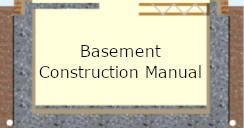
Someone planning a build in Virginia Water paid me the usual fee in 2021 to answer all their questions. Dozens of emails over the next year until on July 30th 2022 I got this: "Thanks for the email
We’re going for waterproof concrete and external membrane". Which meant they were going ahead without me.
I didn't hear any more until 20th September 2025, when I got this Whatsapp message.
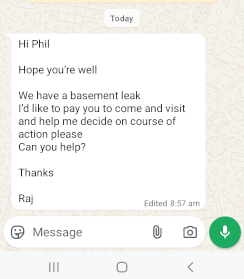
Apparently, both the external membrane and the waterproof concrete have failed.
|
|
In your business, the workforce side might depend on your repeat business. In house basement construction they almost never will.
When both win, when the sub-contractor cuts enough corners to still profit when under-paid, the client loses because they are left with a whole lot of problems.
|
|
When I last worked for a large company, the QSs would refuse to pay sub-contractors for reasonable extras, but they would successfully claim those same extras from the client and keep all of it.
|
|
This web site is about building a problem-free basement structure completely waterproof from the reinforced concrete alone. Right First Time, and not entering into a contract is the first and most necessary step to achieving that.
Since 2004, I built many basements for people with a fixed priced contract.
Typically, in a year, 3 would go to plan and I would make a living.
Another would go very well and I kept some contingency money for myself.
But one would go badly, usually because the client had not investigated the ground fully, and I would lose my shirt.
For years I worked hard but only scraped a living.
But sometimes, and every time since 2017, I would be paid by the day. The client would pay the labour and for plant and materials as we went along.
I would manage, train and supervise as required with the client's best interests at heart.
If the client or I did not like what someone was doing, the client paid them up to date and told them not to come back. The problem stopped. Very easily.
If the client wanted to change something. No problem. No arguing over money.
Most of the time the clients behaved themselves, I saved them 30% - even more if it was an extension and they had to pay VAT because I would make sure neither I nor the labour were VAT registered - and they were happy with the outcome.
Since 2017 every client of mine was as happy as me with the outcome.
I am convinced that private clients are much happier if they do not enter into a contract. It allows them to speak up and be listened to.
It allows them to stop anything they don't like. It allows them to make changes without penalties.
Many people think they can sue a contractor if they find faults. The law says you cannot. Read the page about Construction Law.
You don't find faults immediately because basements are built in holes that fill up with rain and muck. Then the basement fills up with rain and muck and waits for the building above it to be built - until you get your roof on, windows in and you pump the rain out. You still won't always see leaks till the basement is dried and it rains persistently. Your rogue basement contractor has long gone by then.
Many people think they found a good team. Honest people and the first men to start impress them. But, as the weeks go by, the good guys seem to get replaced by others who don't really know what to do. Phone calls get promises but they don't get the good guys back for more than a couple of days.
How I got cheated several times was with a poor soil investigation.
The very nice people who got me to agree to build their basement for a fixed price, despite the information looking like it might not be complete, turned very nasty indeed when the missing information turned into 'someone has to find more money'. It is usually absolutely vital that you get a professional and thorough soil investigation report before you expect to hire a good contractor.
If you don't have it
a good contractor should refuse to enter discussions.
I suspect most contractors would take what money they could and do a runner when things turn bad.
The irony is, in every case where we fell out I would have carried on if they had covered the extra cost. But after we fell out they needed to find a firm who would sort things out - and that always costs even more in the end.
One of them, I wanted £18,000 more but I learned it cost them £40,000 more.
If you are honest and you want a good outcome, hire a manager and pay everyone yourself.
Keep a close enough eye on things to let go anyone you don't feel happy enough with, especially if that is your manager.
Supervision is essential.
Otherwise, usually:
-
Water will be added to concrete and instead of being waterproof it will be porous
-
Concrete will be segregated by over compaction
-
A contractor will usually form concrete kickers which will be expensive and all but impossible to waterproof later
-
A contractor will usually leave an otherwise waterproof concrete wall full of holes
-
Joints will not be scabbled (roughened properly), cleaned or kept clean. Expensive tapes and strips will not be fitted or fixed properly.
-
Formwork will be too deep to deliver concrete to the bottom in good condition
-
Formwork will be too deep to get the vibrating poker to the bottom to properly remove all the air
-
Formwork will be loosened too early, releasing moisture essential for the chemical reactions yet to take place before the concrete becomes waterproof.
Quite honestly, I cannot imagine why these contractors made a void with polystyrene when the concrete should be helping to hold up the house. They hid it. It wasn't discovered for 8 years.
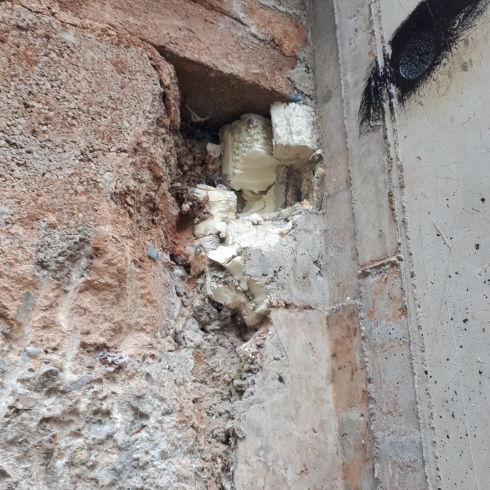
|
|
This segregation happened when the concrete was released in formwork too tall and as the concrete crashed through the steel reinforcement it lost cement slurry as it coated the formwork inside and the first stones arrived all alone.
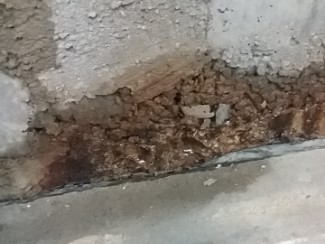
Contractors always use formwork too tall because it means they hire less and use it many times to form many sections. But this also means many more joints.
|
|
I was sent this photo years ago. The main contractor was trying to fix the leaks left by his sub-contractor a year earlier. But this office block was only now getting fitted out. I believe this was a beneath-ground lift pit. A lift pit is the safe area beneath a lift for someone to crouch in and not get squashed if the lift comes down on top of them.
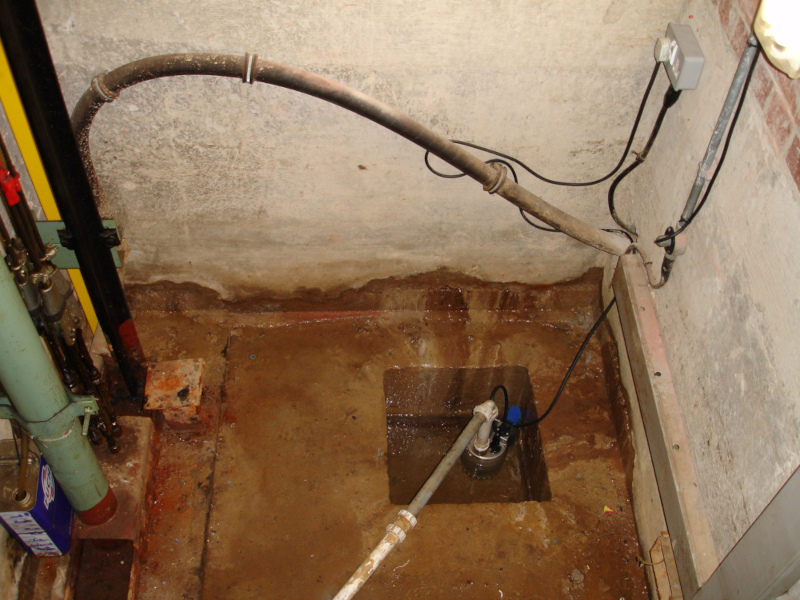
In the UK, contractors always seem to use steel threaded rods in plastic sleeves. They take the rods out to use them again and leave an otherwise waterproof concrete wall full of holes. If they tell their labourer to fix them, you can be sure he won't fix them all properly.
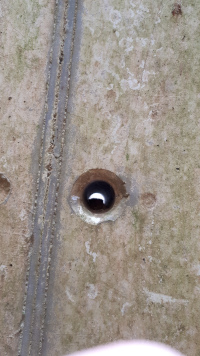
|
|
I was asked to go and see what I could do about the problems in a mansion being built for a footballer in Cheshire. The basement was vast. It should have been finished but they still had water getting in everywhere.
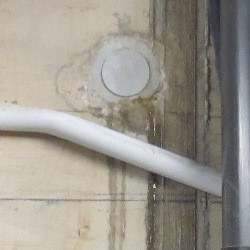
|
|
I hear this so often. The main contractor brought in a sub-contractor who said he did this work all the time. What he really meant was he is a formwork carpenter who does this work all the time as a member of a team with a foreman and manager over him to ask for advice and to sort out problems.
On his own and finding himself in charge he got it terribly wrong.
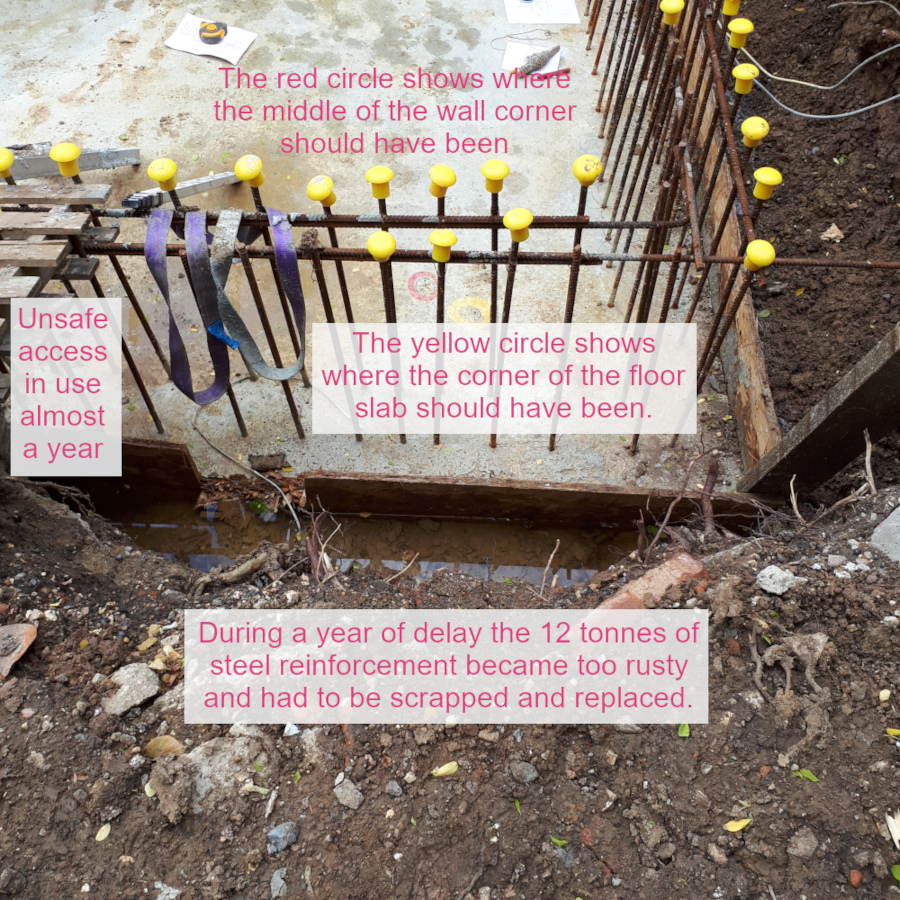
The problem with wonderful-sounding strips that expand in a joint and, it is claimed, seal a leak, is they come out of the box rolled up and they don't want to stick on straight. Nailing them makes them even worse. Where concrete gets behind the tape there is nothing in the joint after all.
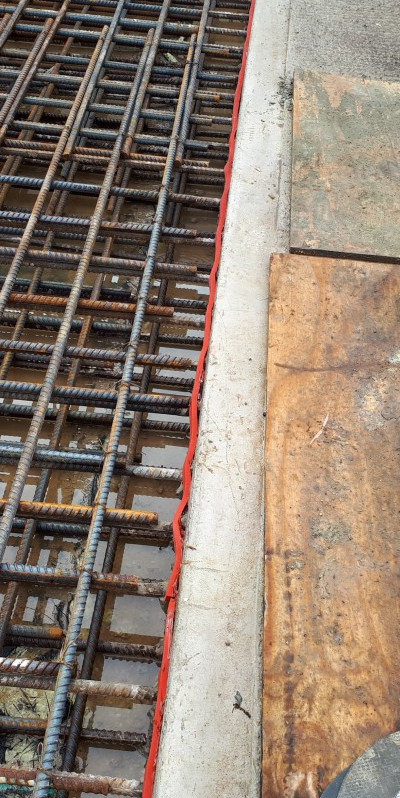
|
|
|
But if there is a joint strip that I know works for one team (who have plenty of work with the firm that employs them) it is Fradiflex. But in this case, a contractor did not take off the protective film and neither did they overlap the joints properly.
The white stuff is the protective film that should have been removed to expose the bitumen paint.
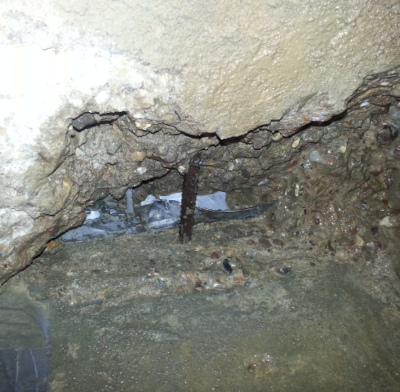
It's chiselled out because it is leaking.
|
First, this corner pile was augered and filled in the wrong place. It should have been discovered and another put in just behind so that the first could have been chiselled away when they excavated.
Second. There should never have been this gap left between waterproof concrete walls.
Everyone on site would have known about this when they set their formwork up.
Everyone kept quiet.
|
|
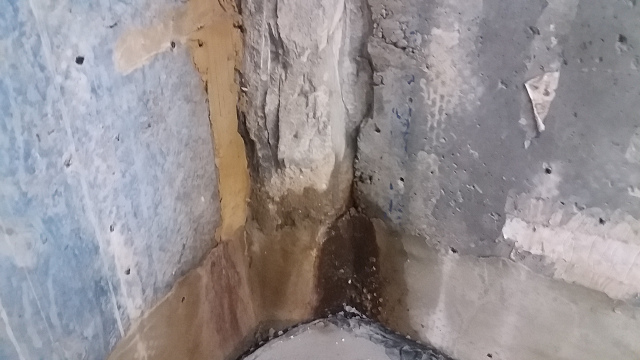
|
A video showing several problems all at once. Rebar with no cover, honeycombing, and dirt washed out of the joint.
It is 2 minutes long. Just watch a few seconds and read the notes underneath. Then close it.

|
|
The amount of excess water coming out of this concrete is ridiculous.
Extra water gets added at site because it makes the labourers' work spreading it a lot easier.
But it weakens the concrete and causes drying shrinkage cracks a few years later.
Someone will be fixing a problem over the Elizabeth line. I hope it is a leak and not a collapse that kills someone.
If they let the BBC film it they must think it is normal.
What do they get up to when no one is looking?
|
This is the 2009 way of building a basement still being specified and built today in contravention of the new edition of BS8102 and the Building Regulation C2. These are practices that must stop.
Practices that leak causing the internal drainage pump or the discharge plumbing to fail.
Seasoned professionals will all use steel threaded rods in a plastic sleeve. They leave the plastic sleeve as a hole through otherwise waterproof concrete; or else they fill the holes but some leak.
I was sent these images by a prospective client looking for a different basement builder, so I don't know where he found them. He is planning a second basement and he says his first basement leaks - so perhaps this is it.
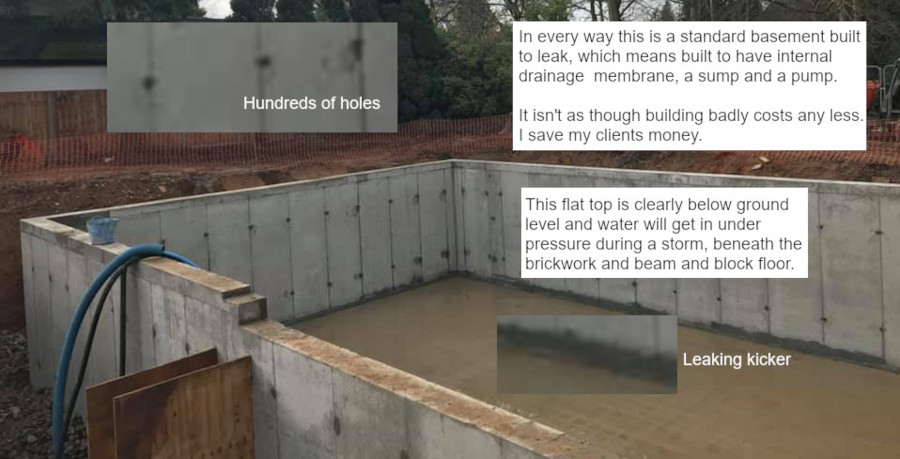
And here we see the same hole destined to get the Delta-type sump for a pump, backup pump and backup power supply. All very expensive and not guaranteed to work either.
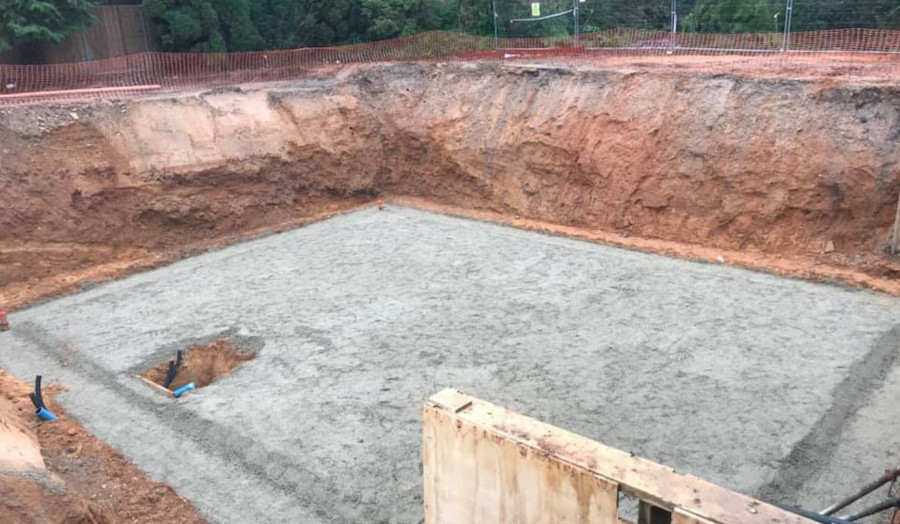
PLUS. HORROR !!!! The pipes and ducts connecting the outside to the inside are underground but not set in any waterproof concrete.
The shingle you can see in the photo above would have damaged the joints between sections of duct when it was tipped in. When the shingle fills up during a severe storm, water could flood in through these various duct joints far faster than the pump could pump it out. Pushing the drainage membrane off the wall, flooding the basement temporarily and leaving plasterboard, decoration and furnishings ruined.
No fancy warranty from a respected waterproofing company will cover any of this and all the 10 year latent defects insurers exclude waterproofing below ground.
These built-in errors are at the risk of the householder. No one else.
The family who live here won't be happy when it floods.
Also filmed by the BBC and with some endorsement by the Open University as well, another example of lots of water added at site. This time to get through closely packed steel reinforcement, that should have been tied differently to leave wider gaps, without any effort on the part of the labourers.
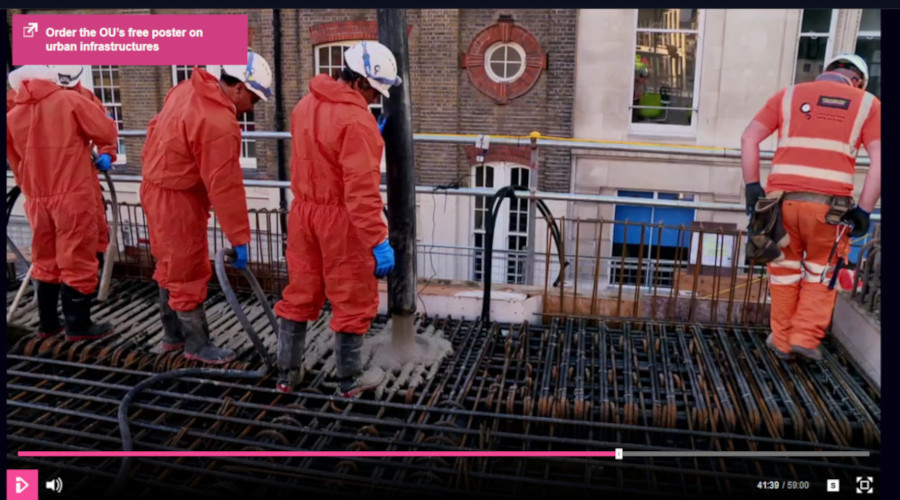
I was once asked to be the eyes and ears for the client and to watch and report on his contractor, just on concrete pour days, a large London firm who really boast how good they are.
Building Control had already been and approved the steel.
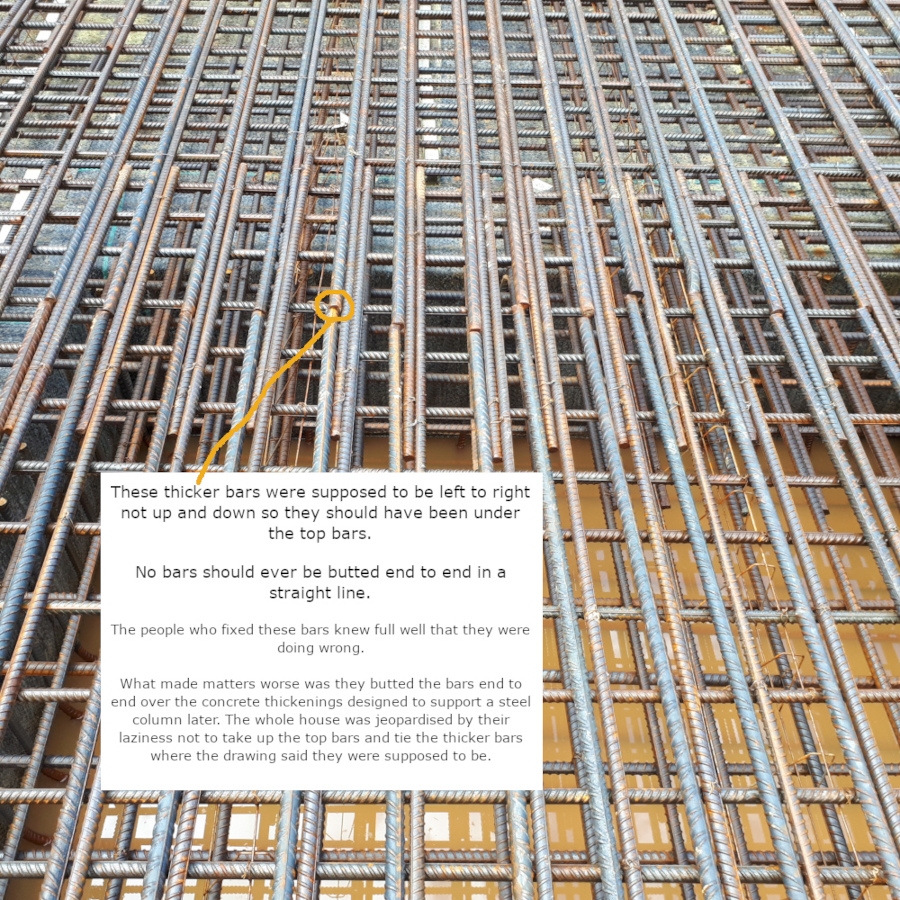
I had no authority over this gang but they let me tie the top bars properly and add steel where their cage was too low before they got that far with the concrete.
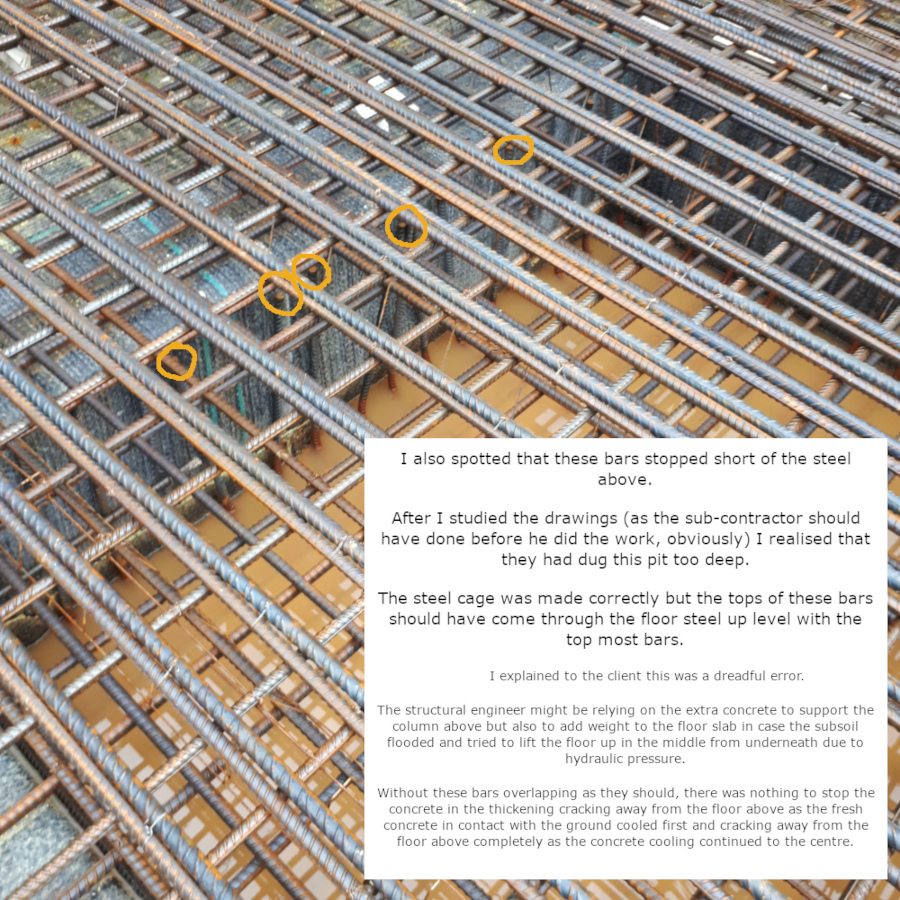
Thermal shrinkage cracking.
My solution is to pour all the wall all round in one go without joints and in two pours, bottom and top. My way needs more formwork and more steel reinforcement. But it is waterproof.
The usual contractor solution is to hire less formwork. Just enough to use many times and complete the work within the minimum 4 week hire.
But that will mean taller formwork, which means leaking voids at the bottom of the wall, and a lot of vertical joints which are also prone to leak.
This is where I explain my better solution to structural engineers.
You can see in this pour sequence that they plan to pour in 5 pours. The 5s are mostly smaller infill sections to finish.
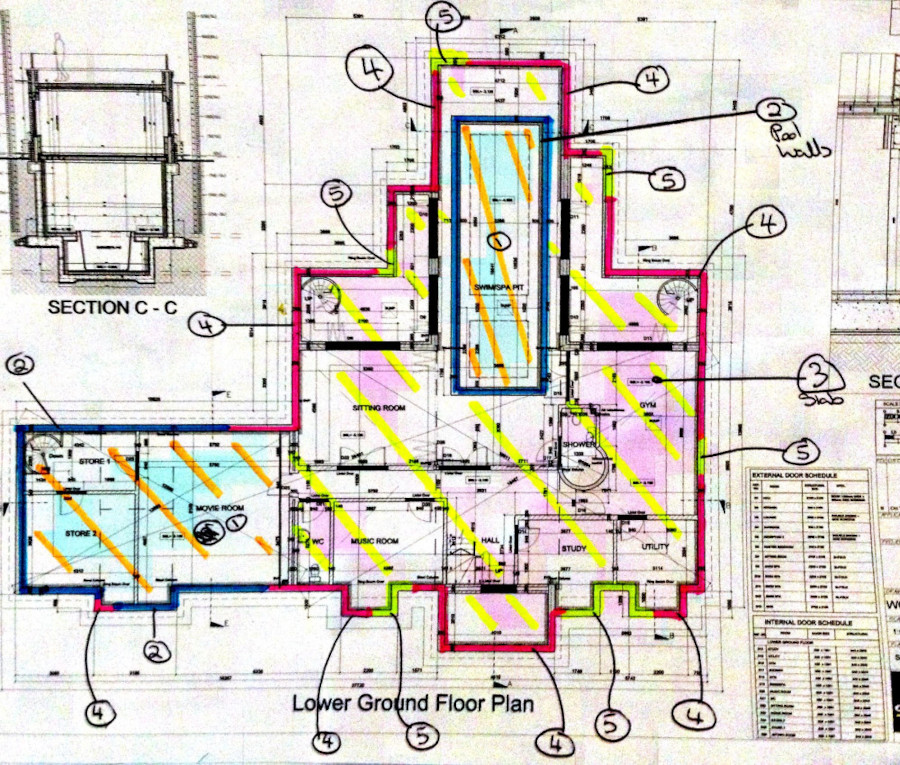
I think this usual practice is probably more expensive.
It could be cheaper for the contractor, because he can run away with the money months before the leaks are discovered; which will only be after the roof is on, windows are in, the basement pumped of rain water that collected and the basement cleaned and dried.
The client foots these extra costs of fixing leaks.
Here are some links to companies that will repair your leaks for you.
Sika
Newton
David Ball Group. The people who sell Pudlo as well.
Delta
None of my self-build clients have any repairs.
The Basement Expert website is all about avoiding leaks by paying for everything and everyone yourself so that you have the power to stop what looks bad before it is too late.
|
|
Don't use a basement contractor if you want your work done well.
Client mistakes include
-
Getting planning permission for the front of the new house to be in the same place as the house you will knock down - but not getting the old house surveyed first and, therefore, being unable to start the basement where it should be.
-
Not organising building control or latent defects insurance before you knock the previous house down or even before you start work, and having to pay a huge penalty.
-
Not sending in a Form F10 to the Health and Safety Executive before you start work. You will probably get a fine.
-
Not studying the CDM Regulations and how they apply to you. (They apply to everyone so they do apply to you).
-
Not getting a good soil investigation.
-
Not thinking about who you need to build or help you build.
-
Not having anyone competent to at least keep an eye on all contractors.
-
Not doing any basic research to understand the materials you will use if you are in charge, for instance the different ways to buy and have concrete delivered; what men can lift and what requires a crane.
-
SAVING MONEY always seems to cost more.
-
ICF.
-
Entering into a contract with a contractor.
-
Getting planning permission for the front of the new house to be in the same place as the house you will knock down - but not getting the old house surveyed first.
Picture the excavation for your basement. It is the size of your new house, plus half a metre all round, plus sloping sides to be safe.
Everything within 3m of your old home is gone.
Stood in the bottom of your excavation, 3.5m down, you cannot see anything at ground level.
How do you mark, down the bottom of a deep and muddy hole, exactly where the front of the new house should be?
Many people need a land survey before the old house is demolished and to bring back the same surveyors to mark the corners down the excavation. They will leave targets and marks well away from your proposed dig so they can relocate their surveying instrument months later.
Clearly it will be easy to realise later the house is in the wrong place. But few appreciate how difficult it is down a hole with nothing left all around.
Actually, this was my career before basements. I have a reflectorless total station surveying instrument. You could ask me to visit to survey your existing house. I will charge you a day for that visit but you might get a meeting and some advice included as well. I will need to come back to set out your basement down your hole. If I am already on site being paid to train or supervise, I can set out while I am there and only charge a small additional hire charge for the surveying instrument.
-
Not organising building control or latent defects insurance before you knock the previous house down or even before you start work.
If you want someone other than the council to do your building inspections then the council must give you permission to use someone else before you knock the previous house dowm.
If you start work before getting your latent defects insurance fully in place the insurer will charge you a supplementary premium of several thousand pounds.
-
Not sending in a Form F10 to the Health and Safety Executive before you start work.
Projects over a certain size are required by law to submit a Form F10 to the Health and Safety Executive and to display the form in the site office alongside statutory insurance certificates.
-
Not studying the CDM Regulations and how they apply to you. (They apply to everyone so they do apply to you).
There is safety for bullsh%t purposes and there is safety to keep you out of jail. Find out how to keep yourself out of jail here:
www.hse.gov.uk
-
Not getting a good soil investigation.
I have a whole page of warnings on this but still many people who phone me are trying to cut corners.
A good soil investigation is how you get eyes into the ground before you start. A good soil investigation is how you reduce risk. How you avoid contingency costs. Because if £3,000 reveals you have problems you could not afford to overcome, you don't go ahead. You avoid your neighbour's house collapsing and you don't lose everything.
No one, in my experience, who spent £3,000 on a thorough soil investigation wasted a single penny on over-engineering because their engineer did not know what was in the ground, or wasted money on inappropriate work that went to waste etc. etc. etc.
Some years ago now, a client who knows nothing about construction but wants to be in charge of everything, paid off a local builder who had made a start on a basement, paid me off for removing all that previous work, paid off a piling contractor for then putting in 94 piles to support the sides, had me back only to find out his drainage was all wrong ........
When I first went there I looked back at his soil report. I found these two phrases within it:
"A desk study was not commissioned as part of this basic investigation."
"a detailed discussion of all the problems that may arise
during the proposed redevelopment scheme is beyond the scope of this report."
The man had no doubt been offered these two additional services but declined them and after spending nearly £100,000 pounds he still only had a hole.
-
Not thinking about who you need to build or help you build.
Your new home cannot be built by one or two foreigners over here to teach Latin dance or study humanities at university if they never used a shovel before. Yet 2 clients in the past thought that with me there as well they could.
You need different people at different times. Groundworkers, digger driver, lorries, strong labourers, carpenters, steel fixers and so on.
-
Not having anyone competent to at least keep an eye on all contractors.
One job I started I realised we were digging deeper than expected, removing more material from site than expected and digging nearer to the boundaries than expected.
It transpired that the clients had been hoodwinked by the demolition people into the advantages of leaving a solid layer of hardcore all over the site so it would be clean for those following on.
In fact, they left 800mm of hardcore all over the site which might mean they were paid to remove the house they demolished but they just left it.
The clients paid twice for their old house to be taken away.
You only need someone to talk to before saying yes to what might sound a good idea at the time. I will consider what follows on and whether it really helps, so would your architect and structural engineer. They and I are people who work for you. But if you do not know it will be obvious and you will be caught out by someone wise to an opportunity.
|
|
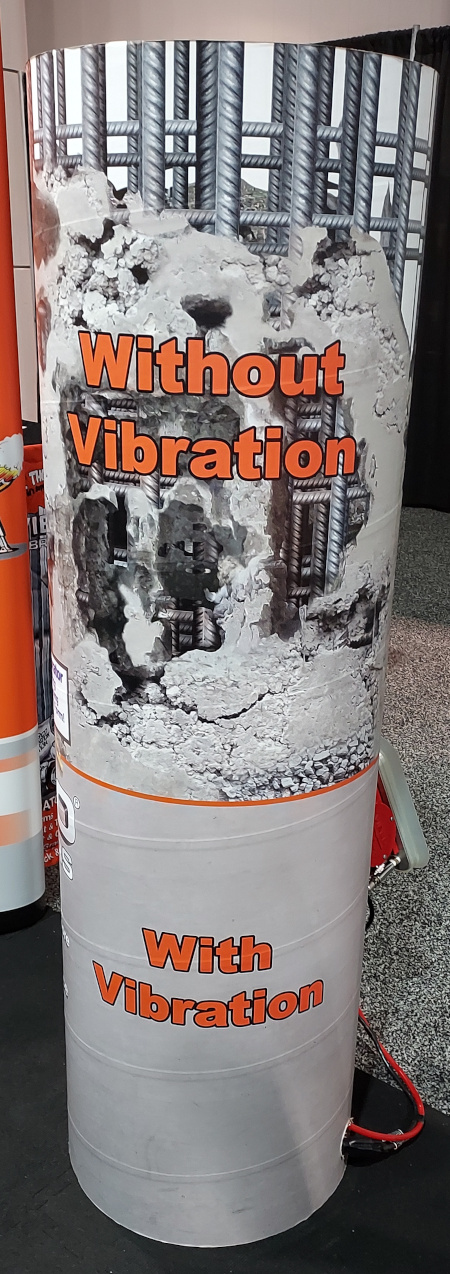
|
-
Not doing any basic research to understand the materials you will use if you are in charge, for instance the different ways to buy and have concrete delivered; what men can lift and what requires a crane.
I cringe when I hear self builders trying to get a good deal without any of the industrial jargon. They may as well have 'Mug' written on their foreheads.
I cringe when the concrete turns up in a truck that mixes it on site when we needed readymix so that we could add chemicals at the correct dose.
I cringe when they hire a concrete pump too small and expect several tonnes of concrete to be carried to the far end in buckets - within 30 minutes because concrete sets.
I cringe when they try to hire plant from a tool hire company or a tool from a plant hire company.
-
Saving money.
Saving money your way, not mine, usually ends up being expensive.
I should say that the 3 most expensive ways self-buiders try to cut corners are
-
Not excavating fully so they get cave ins that are dangerous and more expensive to clear after construction has started.
-
Only having a couple of labourers to work with. Labourers have no skills so you end up doing most of the work. This takes far longer. The right approach is to hire 2 carpenters, 2 bricklayers or groundworkers and 1 strong labourer.
-
Trying to provide scaffold on the cheap. Men get injured falling off scaffold that is unstable or weak. One man, who has worked for me again since, went back to finish a job where I refused to continue and ended up with cracked ribs. No one works well after being frightened or injured. Poor scaffold creates poor value workers.
-
ICF.
Building a basement with ICF is a huge mistake. I explain all the reasons why here.
-
Entering into a contract with a contractor.
Back to the Basement Building Questions Answered menu.

|
Forward to the Basement Building Construction Manual menu.

|
For a fixed fee of £199 I will answer all your questions by email. More details here.

|
Previous Page
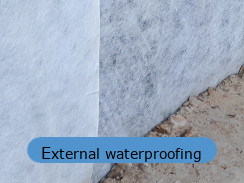
|
|
Next Page

|
|
The Page After That

|
|
|
